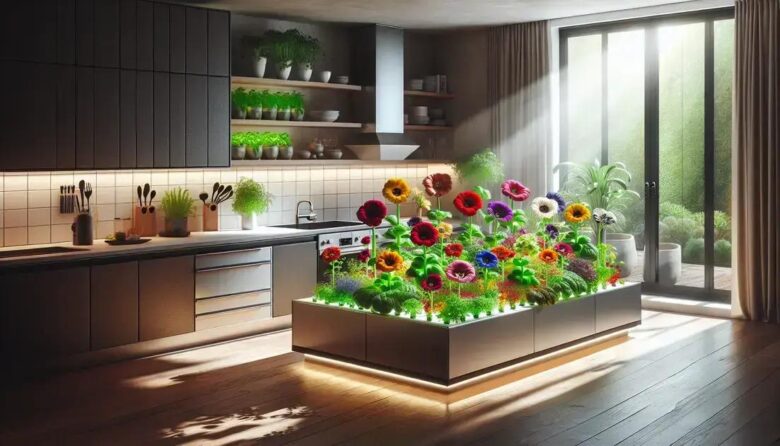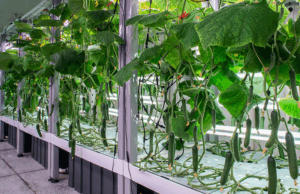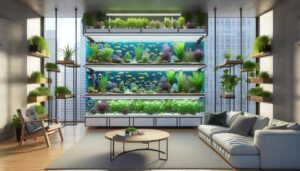Growing edible flowers hydroponically at home offers efficient water use and controlled nutrients, leading to vibrant blooms ideal for culinary use. Favorites include nasturtiums and violas, thriving year-round indoors with essential grow lights and nutrient solutions, enhancing both garden beauty and dish appeal.
Edible flowers in your kitchen? Yep, it’s possible with hydroponics! Ever thought about dazzling your dinner guests with home-grown delicacies? This guide dives into making it a reality by setting up a practical system right in your own space.
what makes edible flowers special?
Edible flowers have been cherished for centuries, not just for their beauty but also for their unique flavors and health benefits. From the mildly peppery taste of nasturtiums to the sweet fragrance of violets, each flower brings something special to the table. They are a wonderful way to add color, texture, and flavor to dishes, enhancing the dining experience.
- Nutrition: Many edible flowers, like pansies and marigolds, are rich in vitamins A and C, making them more than just a pretty garnish.
- Culinary Uses: Incorporate these flowers into salads, desserts, or as finishing touches on savory dishes to create visually stunning plates.
- Aesthetic Appeal: The vibrant colors of edible flowers can elevate the presentation of any meal, making it not only appetizing but also Instagram-worthy.
setting up a hydroponic system at home
Setting up a hydroponic system at home is simpler than you might imagine. This innovative method of growing plants uses mineral nutrient solutions in water, eliminating the need for soil. Start by choosing a suitable space in your home, like a sunny windowsill or a well-lit corner.
Materials Needed: You will need a reservoir for water, a pump for circulation, and a grow light if natural light is limited. Opt for net pots and a growing medium like clay pebbles to support the plants.
Preparation: First, assemble your system by placing the pump in the reservoir and ensuring the water can reach all plants. Position net pots filled with the growing medium, and add seeds or seedlings.
Nutrient Solution: Prepare a balanced nutrient solution following the instructions on a hydroponic fertilizer package. Monitor pH levels regularly, keeping them between 5.5 and 6.5 for optimal growth.
choosing the right flowers for hydroponics
When selecting flowers for your hydroponic garden, it’s essential to consider both the growth requirements and the desired culinary uses. Some flowers thrive in hydroponic systems better than others due to their adaptability and needs.
Start with varieties like nasturtiums and calendula, which are known for their resilience and versatility. These choices bring aesthetic beauty as well as unique flavors to your garden. Choose flowers that complement your culinary preferences, such as borage for a cucumber-like taste or chamomile for its soothing properties.
Ensure your system can provide the necessary light and nutrients. Consider the lighting requirements for each flower, as some may need more intense illumination than others. Nutrient solutions should be matched to the specific needs of the flowers you are growing.
essential tools for indoor gardening
Indoor gardening requires specific tools to create a thriving environment for your plants. Start with a grow light. This tool simulates essential sunlight, crucial if natural light is limited in your space. Choose LED lights for energy efficiency and adjustable spectrums, catering to different growth stages of your plants.
A reliable nutrient delivery system ensures your hydroponic setup provides the necessary minerals. Use a high-quality nutrient solution designed for the specific needs of your chosen flowers. Invest in a pH meter to regularly check the acidity of your solution, aiming for a level between 5.5 and 6.5.
Ventilation is key to maintaining a healthy environment. Use small fans to ensure air circulation, preventing mold and pests. A timer to automate lighting schedules helps keep your plant growth consistent and hassle-free.
maintaining your hydroponic garden
To maintain a healthy hydroponic garden, regular practices ensure your plants thrive. Begin by consistently monitoring water levels in your system. Plants depend on a stable water supply, so refill the reservoir as needed.
Check nutrient solution concentrations weekly to sustain plant growth. Adjust the mixture according to specific plant requirements and system guidelines. A balanced nutrient solution prevents deficiencies and promotes vigor.
Inspect plant health regularly. Look for signs of pests or disease, such as discolored leaves or unusual spots. Early detection allows for prompt intervention, preserving your garden’s health. Use organic pest controls to minimize harm.
Light and temperature conditions must also be monitored. Ensure grow lights are operational and positioned correctly for optimal absorption. Maintain room temperature between 65-75°F to suit a variety of edible flowers.
creative culinary uses for edible flowers
Edible flowers offer unique ways to elevate dishes with color and flavor. In salads, they add a vibrant touch. Try tossing nasturtiums in a fresh green salad for a peppery kick. Use violas and pansies as decorative garnishes on cakes and pastries, adding both beauty and subtle sweetness.
Create stunning drinks by freezing flowers in ice cubes. Add borage ice cubes to a refreshing lemonade or cocktail. For a sweet treat, infuse rose petals into homemade syrups or jellies, imparting a lovely aroma and flavor.
Experiment with savory dishes by incorporating calendula petals into rice or pasta, providing both color and a hint of spice. Garnish grilled meats or fish with chive blossoms for a mild onion flavor.
The journey of cultivating edible flowers at home
Growing edible flowers hydroponically in your kitchen can be a rewarding experience. You’ve learned about selecting the right flowers, setting up your hydroponic system, and maintaining it effectively.
This endeavor not only beautifies your indoor space but also enriches your culinary creations, adding vibrant colors and flavors to your dishes.
As you experiment with creative culinary uses for your flowers, from salads to desserts, you’re enhancing meals while indulging in a sustainable hobby.
Hydroponics opens a world of urban gardening possibilities, allowing you to enjoy the beauty and benefits of edible flowers right at home.
FAQ – Frequently Asked Questions about Growing Edible Flowers Hydroponically
What are the benefits of growing edible flowers hydroponically?
Hydroponics allows for efficient water use, controlled nutrition, and year-round growth, producing high-quality, flavorful flowers.
Which edible flowers are easiest to grow at home?
Nasturtiums, calendula, and violas are great starter options due to their hardiness and culinary versatility.
Do I need special equipment to start hydroponic gardening?
Yes, a basic setup includes a water reservoir, grow lights, a nutrient solution, and net pots or containers for the plants.
How much light do edible flowers need indoors?
Most edible flowers require 10-12 hours of light daily, which can be met using LED grow lights if natural light is insufficient.
Can I use edible flowers in savory dishes?
Absolutely! Flowers like chive blossoms add mild onion flavor to savory foods, while calendula adds color and spice to dishes.
Is it safe to consume all flowers grown hydroponically?
Only consume flowers that are confirmed as edible and have been grown in safe conditions without harmful chemicals.



